Samsung Note 10 Screen and Digitizer Replacement Guide


Intro
The Samsung Note 10 has made waves in the market since its release. Its sleek design, vibrant display, and top-tier performance cater to a variety of users. However, despite its outstanding features, mishaps can occur—whether it's an unexpected drop, a run-in with moisture, or even a simple hardware malfunction. Such incidents often lead to the need for a screen and digitizer replacement. This guide aims to equip you with the knowledge necessary to tackle this repair without breaking a sweat.
In this detailed exploration, we will break down the reasons behind a screen and digitizer replacement, discuss the inherent challenges, and present you with a step-by-step framework for carrying out this repair. By understanding the essential tools and techniques required, you stand a better chance of revitalizing your device—if not, it might suggest reaching out for professional help.
Navigating through the complexities of this task can feel like stumbling through a dark room; however, with the right information and strategies at your disposal, you’ll soon be back in control, keeping your Samsung Note 10 functioning at its best.
Preface to Samsung Note Screen and Digitizer
The screen and digitizer in the Samsung Note 10 play pivotal roles in enhancing user experience. If the screen is the face of the device, the digitizer is its lifeline, translating touch actions into commands. Replacing these components can transform a user’s interaction from frustrating to seamless.
Whether it’s a minor scratch or a complete breakage, understanding the functionalities and common problems can save you time and money in repairs. With the Note 10 being a flagship device, knowing when and how to replace its screen and digitizer can keep your device running like new.
Understanding Screen and Digitizer Functionality
To grasp the importance of screen and digitizer replacement, it's essential to break down their functions. The screen is where all visuals appear — bright, vibrant colors that showcase everything from app interfaces to video content. Meanwhile, the digitizer sits beneath the glass, detecting finger movements and pressure. This interaction facilitates navigation, multitasking, and responsive gameplay. Without a properly functioning digitizer, even a pristine screen may feel dead.
Numerous factors contribute to their wear and tear, often leading to replacement. Awareness of these aspects is crucial for any tech enthusiast, gamer, or computer builder who values performance and usability in their devices.
Common Issues Leading to Replacement
Over time, various issues can arise that necessitate the replacement of the Samsung Note 10's screen and digitizer. Identifying these problems early can prevent further complications and ensure the device remains operational. Here are some of the most common issues:
Cracks and Shattered Glass
Cracks and shattered glass are usually the most visible signs that replacement is needed. A significant drop can quickly turn your device’s screen into a spiderweb of cracks. Beyond the aesthetic displeasure, broken glass can be hazardous. Sharp edges might lead to cuts, and deeper cracks can affect the display's integrity.
The compelling characteristic of cracked screens is the immediate visual impact; there's often no mistaking that something has gone wrong. For many users, the urge to replace it stems not just from necessity but from a desire for a clear, unobstructed visual experience.
However, opting for a replacement can be a double-edged sword. While it restores functionality, it might not be the cheapest route. Sourcing quality parts can be tricky; cheap replacements might lead to further troubles down the line. Investing in a quality repair ensures that the device retains its premium feel.
Unresponsive Touchscreen
An unresponsive touchscreen can bring your tech-infused life to a screeching halt. It's frustrating when taps and swipes don't register, leading to endless fumbling and possibly even device failure. This issue typically arises from problems either with the digitizer or the software. A faulty digitizer will ignore commands sent by the fingers, making the phone feel almost like a brick. Touchscreen unresponsiveness demands attention, as it signifies deeper issues that hamper the user experience.
Why is it a popular topic? Because it affects interactions daily. If the device is your primary communication tool, you can’t be living on borrowed time waiting for it to fail completely. The uniqueness of this problem lies not just in its impact but also in its range of possible causes — from software glitches to physical damage. Many users opt for a hardware fix rather than risking data loss with software restoration.
Display Color Issues
Display color issues can manifest in several ways: dull colors, discoloration, or even completely black pixels. These problems often arise from screen burn-in or failure in the digitizer itself. Contrast levels might dip or fluctuate without warning, affecting everything from reading text to immersive gaming experiences. This kind of malfunction often creeps up on users, who might initially dismiss it as a minor glitch.
However, prolonged color issues can lead to severe usability challenges. Many consumers find themselves grappling with the decision of whether to replace the screen or attempt a repair. The color display serves as an interface to the digital world, and when it falters, the overall experience is compromised. The need to fix these problems can drive enthusiasts and casual users alike toward researching repair options frequently.
In summary, understanding the main issues that can occur with the Samsung Note 10's screen and digitizer lays a solid foundation for making informed decisions regarding maintenance and repairs.
Importance of Professional Assessment
When it comes to the replacement of the Samsung Note 10 screen and digitizer, one might think it's straightforward or something they can tackle themselves. However, it's crucial to understand that sometimes it's wise to consult a professional. A professional assessment can save users not only time but potentially a lot of trouble down the road.
The first element to consider is expertise. Technicians who specialize in screen replacements have a wealth of experience. They've faced various issues that can arise during repairs that typical users may not even anticipate. For example, while doing a DIY job, one might accidentally damage internal components, leading to greater costs and more complex repairs.
Another benefit is the use of advanced diagnostic tools. These tools help in making a quick and effective assessment of issues. A technician can use specialized equipment that identifies defects beyond a crack or shattered glass, such as problems with the display backlight or digitizer responsiveness. This kind of thorough evaluation ensures that all issues are addressed promptly.
It’s also worth noting that professionals often provide a warranty for their services. This means if something goes awry after the repair, you may have the option for a quick fix at little to no extra charge. It gives peace of mind, knowing that the work is backed and that you won’t have to dig back into your pocket for inevitable follow-up repairs.
Additionally, with the growing complexity of modern smartphones, attempting repairs without proper knowledge can be daunting. Consider the adhesive used to secure screens; it's not just a matter of slapping on some glue and hoping for the best. Using the right materials, paired with the right technique, can be the difference between a flawless installation and a poor user experience.
"A Stitch in Time Saves Nine" — addressing issues early can often prevent more severe complications later on.
When to Seek Professional Help
There are clear signals indicating when it's time to reach out to a specialist. If the screen is cracked but the phone seems to operate normally, you might think you can hold out for a bit. This can be a slippery slope; minor cracks often lead to bigger issues down the line. If you find yourself dealing with an unresponsive or flickering display, that’s a red flag. Moreover, if the touch functionality becomes sporadic or erratic, seeking professional help should be your next move.
Also, if you are uncertain about the tools and steps involved in replacing the screen, or if you’ve attempted a repair without success, getting professional assistance can save both time and frustration. Trying to fix something without proper know-how can become a recipe for disaster.
Diagnostic Tools Used by Technicians
Professional technicians commonly employ several diagnostic tools that can greatly aid in identifying and resolving issues accurately. For instance:
- Multimeter: Utilized for checking circuit continuity and battery health, ensuring power is correctly flowing to the components.
- Heat Gun: This tool is essential for softening adhesive, making it easier to separate the screen from the main body without damaging other internal components.
- Screen Tester: A specific device that checks whether the new screen functions correctly before installation, saving time and effort in the long run.
Using these tools, technicians can pinpoint problems, assuring a thorough repair with optimal outcomes. This level of precision and thoroughness is challenging to replicate without similar equipment, making the case for professional help even stronger.
Tools Required for Replacement
When it comes to replacing the screen and digitizer of a Samsung Note 10, having the right tools on hand is paramount. Not only do proper tools streamline the process, but they also minimize the risk of damaging your device further. Each tool serves a specific purpose, meaning that the quality of your repair relies heavily on what you use. This section will detail the essential components of your repair kit, as well as optional tools that can enhance your efficiency.
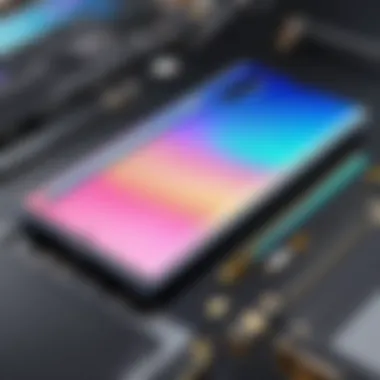
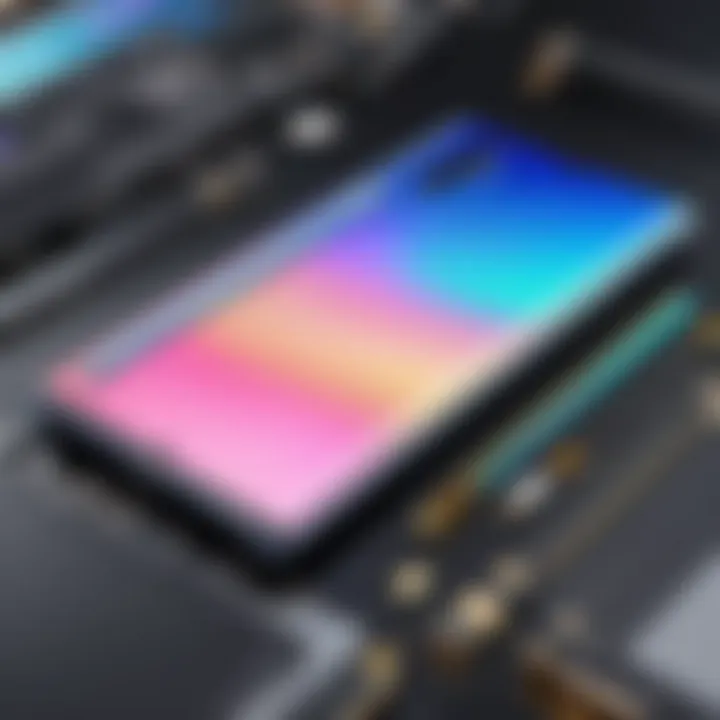
Essential Repair Kit Components
Opening Tools
Opening tools are the unsung heroes of any DIY repair job. They allow access to the delicate interior of the Samsung Note 10 without marring the surfaces or damaging internal components. A standard choice is plastic pry tools or spudgers, which provide a firm yet gentle way to separate panels and components. One notable advantage is they reduce the likelihood of scratching the phone body.
- Key Characteristic: Non-conductive often made of plastic, these tools mitigate the risk of electrical shorts during disassembly.
- Unique Feature: Their design typically includes a tapered edge for coaxing apart adhesive bonds without applying excessive force.
- Advantage: These tools are affordable and come specifically sized for mobile devices, making them a beneficial choice in this repair process.
Screwdrivers
Screwdrivers are vital for loosening screws that hold the assembly together. Precision screwdrivers are particularly important here, as the screws are often small and easy to lose. Look for a set that includes a Phillips head and a Pentalobe screwdriver, which are commonly used in Samsung devices.
- Key Characteristic: A magnetic tip can be highly useful for preventing screws from falling.
- Unique Feature: Many precision screwdriver sets come with interchangeable bits, so you have the flexibility for various devices.
- Advantage: Using high-quality screwdrivers prevents stripping the screws, which can be a setback during a repair.
Adhesive and Cleaning Supplies
Replacing the screen entails re-adhering the new components, making adhesive strips an essential item in your toolkit. Additionally, cleaning supplies such as isopropyl alcohol and microfiber cloths play a significant role in preparing surfaces for a smooth application. Proper adhesion is crucial for ensuring the new screen works correctly and lasts long.
- Key Characteristic: Adhesives designed specifically for mobile devices offer the right strength and flexibility needed for a durable bond.
- Unique Feature: Some kits include pre-cut adhesive strips tailored for specific devices, ensuring an accurate fit that simplifies installation.
- Advantage: Cleaning supplies ensure that surfaces are free from dust or oils, which could compromise the adhesive properties and overall quality of the repair.
Optional Tools for Enhanced Repair
While a basic set of tools will cover most of your needs, there are optional tools that can enhance your repair experience. For example, a heat gun or hairdryer can loosen the adhesive on the screen and make disassembly easier. Similarly, an anti-static wrist strap can help prevent static electricity from damaging sensitive components during the repair.
Exploring a mix of essential and optional tools equips you for a successful screen replacement for your Samsung Note 10, making each step of the process smoother and more efficient.
Step-by-Step Replacement Process
Replacing the screen and digitizer on your Samsung Note 10 is not just a technical task but also a meticulous art form. Taking the time to understand and follow each step meticulously can significantly improve the chances of a successful repair. When you engage in this process, it’s essential to recognize the order and flow of each step, making sure that nothing is skipped. Each action you take lays the groundwork for the next part of the replacement, which makes a comprehensive step-by-step guide invaluable. Missing even the subtle details can lead to greater complications down the line. Let's dive into the specifics with careful consideration of each phase.
Preparation and Precautions
Before diving into the actual replacement, precauotions can save a world of future headaches. The steps in this preparatory phase center around ensuring the safety of the device and the person working on it.
Backup Data
Backing up data may seem like a chore, but it’s an indispensable step when tackling a repair. If something goes awry during the replacement, losing irreplaceable data can be disastrous. Most notably, the sheer peace of mind that comes from knowing that photos, contacts, and important files are preserved is certainly worth the minimal effort.
The key characteristic of this process is its ability to create a safety net. Popular options for backup include cloud services like Google Drive and Dropbox. These services provide an easy-to-use solution that can be accessed from anywhere.
While there are risks related to data loss if back up is missed, the distinct advantage of having your data safe far outweighs any inconvenience. Make it a habit—before every significant operation, your data should always come first.
Power Down Device
Powering down the device before starting any repair is a vital step in ensuring safety. An unexpected power surge or short circuit can easily lead to further damage or even personal injury. This simple action of shutting the device off might prevent an array of complications.
The core aspect here is the elimination of electrical hazards. It’s a straightforward choice for those engaging in repairs, acting as a barrier to costly mistakes. This can be particularly crucial for individuals who aren't seasoned tech enthusiasts; the less excitement caused by live components, the better!
Moreover, as long as it takes to hold the power button and select 'Power Off', this can play a major role in sustaining the overall integrity of the device. All in all, it pays to be cautious.
Use an Anti-Static Wrist Strap
By using an anti-static wrist strap, you can prevent static electricity from wreaking havoc on the delicate components of your Samsung Note 10 once disassembly gets underway. The key characteristic of these straps is their ability to ground you, which is essentially vital for any electronics repair.
Investing in an anti-static wrist strap means you’re making a wise choice to reduce the risk of electrostatic discharge damaging sensitive parts. It’s a rare peace of mind that comes from a small piece of gear.
A unique feature is that most straps are adjustable, allowing them to fit comfortably on various wrist sizes. They may not be the center of attention in toolkits, but neglecting their use can lead to unexpected outcomes. Don’t overlook the basics.
Disassembly Steps
Once your device is prepped, it’s time to get into the thick of it: taking things apart.
Removing the Back Cover
The first step in disassembly is often removing the back cover. This crucial opening can feel daunting, especially for new users, but it is an essential milestone in device repair. The unique aspect of this step lies in its requirement for precision; one wrong move can cause damage to the phone body.
While it may initially seem straightforward, ensuring that the cover comes off cleanly keeps the whole process running smoothly. Plus, it saves time in the long run, avoiding reworking that’s needed if you damage the cover employing excessive force.
Disconnecting Battery and Components
Disconnecting the battery is a fundamental part of the disassembly. It’s not only about taking apart but prioritizing safety. The significant contribution it offers is mainly centered around preventing electrical short circuits when working on the device.
This first act of safety can greatly influence the outcome of a repair. It’s a well-accepted best practice that many professionals advocate for. The hassle of having to remove components later due to a power-related accident isn’t a situation anyone wants to find themselves in. So, heed this wisdom: always disconnect the battery first.
Extracting the Old Screen
Now comes the moment where you’ll be able to lift out the old screen carefully. This step requires concentration and gentleness. The extraction not only involves detaching the display assembly but also delicately navigating the securing mechanisms around it.
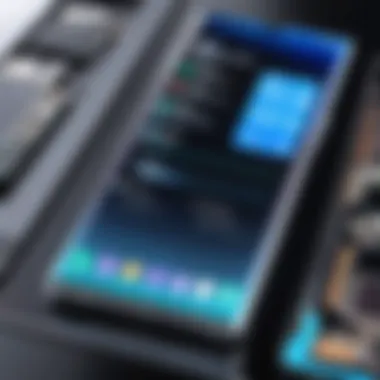
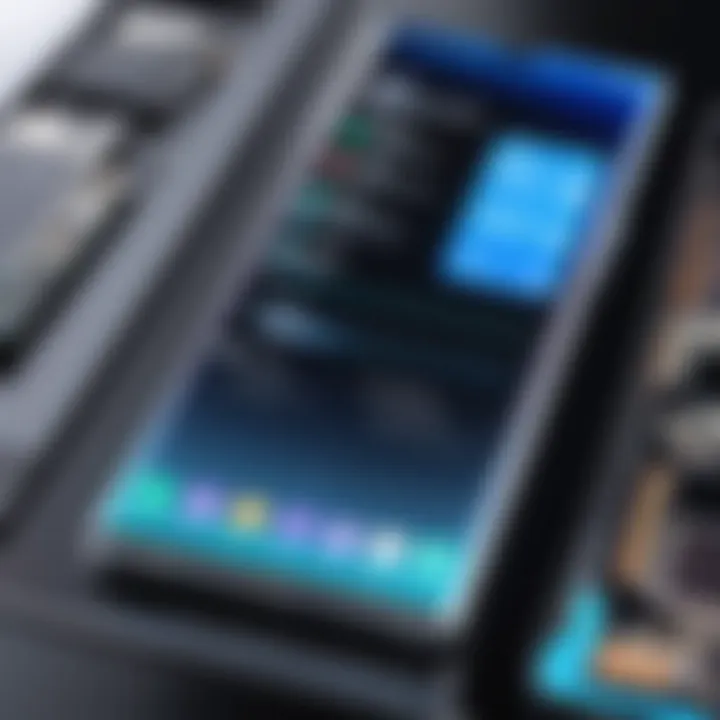
What makes this crucial is the distinct risk involved in hastily removing components that are still affixed. While others might rush through, taking your time to ensure everything is released properly can save significant time in reassembly later. Remember, patience pays off, especially when dealing with tiny connectors and flex cables.
Installing the New Screen and Digitizer
After taking the old screen out, now begins the rejuvenating phase: installation.
Preparing the New Assembly
Once the old components are extracted, preparing the new assembly is the next logical step. This includes making sure the new screen is ready to be installed, checking for any obstructions and confirming compatibility with the device.
An important aspect here is that a well-prepared assembly will facilitate a smoother installation process. The benefit lies in ensuring that everything from connectors to adhesive positions is adhered properly. The big win is a reduced chance of having to redo any work if things don’t align correctly.
Securing the Screen in Place
Securing the new screen is a detailed process that ensures it fits snugly in place. This step requires focus since a poor fit can lead to loose components or future screen issues. By applying pressure in calculated areas, you’re essentially creating a reliable hold on the display that can withstand daily usage.
It’s beneficial to make sure that securing elements are easy to access during this task. Ensuring there are no gaps during installation can create a long-lasting fit, avoiding potential breakage down the line due to improper installation.
Reconnecting Components
To finalize the installation, reconnecting the components is a necessary step. This may seem trivial, but inadequate connections can lead to failures in functionality. Being meticulous in securing each cable reliably guarantees your device will function correctly post-repair.
The key here is careful attention to detail. Every connection should feel deliberate, ensuring that nothing is loosely connected that could cause defects later. This final step directly contributes to the overall success of the installation, making it a pivotal part of the process.
"A careful approach can save you time, costs, and the heartache of replacing components again.”
Taking these steps in careful sequence not only improves your chances of success but also teaches valuable lessons on the process of repairing technology.
With patience and thoroughness, most tech enthusiasts can ultimately take pride in a job well done when they look at their revived Samsung Note 10.
Post-Replacement Considerations
After you’ve gone through the laborious process of replacing the screen and digitizer on your Samsung Note 10, it’s crucial to consider a few factors to ensure everything is functioning properly and that the repair will stand the test of time. These post-replacement considerations can not only help in confirming the quality of your work but also prevent potential issues in the near future. Here’s a deep dive into what you need to focus on.
Testing the New Setup
Once the new screen and digitizer is installed, it’s time to put it to the test to see if everything is operating as it should. This involves three major checks: touchscreen responsiveness, display quality, and the functionality of other components.
Touchscreen Responsiveness
Touchscreen responsiveness is vital because it defines how well a user can interact with the device. After the repair, ideally, the touch system should be just as responsive as when the device was first unwrapped. A responsive touchscreen means taps, swipes, and multi-touch gestures register accurately and without delay.
The key characteristic of touchscreen responsiveness is its sensitivity to touch, which can smooth the user experience if done right. This is significant since a sluggish or inaccurate touch response could lead to frustration. When testing, try to perform various gestures across the screen. This includes everything from tapping icons to swiping through pages. If inconsistencies arise, it might indicate that something was not properly connected during reassembly.
That said, a unique feature to watch for is the touch response curve. Modern screens often have an adaptive touch response that changes based on pressure. Sometimes you might feel the screen responding differently under varied touch pressures, which can be an advantage in gaming scenarios where precision is crucial. If your new screen has any dead zones, it’s a disadvantage, as such compromises can hinder app usage and overall device accessibility.
Display Quality Check
The display quality check isn't just about how bright the screen gets. It encompasses a range of factors including color accuracy, contrast levels, and pixel clarity. A good display will have rich colors with version of blacks that don’t look gray.
Scrutinizing display quality can help identify any manufacturing defects or installation errors. It’s not just beneficial; it’s essential for maximizing the visual experience of your Samsung Note 10. You know the screens on these devices are remarkable, and replicating that should be the goal. Use vibrant images or videos to check how the new screen handles colors. If it struggles to showcase the true tones of the image, you may be looking at a faulty part or a poorly conducted installation.
A unique feature you might also want to check is the brightness setting; some screens can dim from ambient light. Understand that although replacement parts might be cheaper, they can sometimes sacrifice quality, and display quality might suffer.
Functionality of Other Components
While the screen and digitizer are central to the device's functionality, other components must be checked to verify everything works in harmony. This includes the front camera, sensors, and buttons’ functionality. The last thing you want is to fix one issue and find more cropping up elsewhere.
It’s crucial to ensure no components were mishandled during the disassembly and replacement processes. If the touchscreen works but the front-facing camera is malfunctioning, that’s a clear cut sign something’s amiss. These components are all interconnected, so feedback from one can influence the others significantly. This highlights the integrated nature of today’s mobile technology.
Pay special attention to the earpiece speaker and microphone as well. You wouldn't want to make calls only to discover sound quality is severely lacking. Conduct tests like recording a voice memo or making a quick call to verify functionality.
Reassembling the Device
Once the new screen has passed all checks, it’s time to reassemble your device. Take it slow here; rushing this step could lead to improper sealing or even more damage. Make sure to align components correctly and ensure everything snaps into place the way it should. Regularly check that the screws are tight, connections are secure, and the back cover fits snugly.
While it might feel tempting to skip these last checks, they are your safety net. Ensure screwdriver sizes are properly matched to avoid stripping screws. The integrity of your device relies not just on the new screen but on how well everything else has been put back together.
In short, thorough testing and careful reassembly after a screen replacement can ensure your Samsung Note 10 runs smoothly and has a longer lifespan after the repair.
Potential Risks and Mitigation
Repairing the screen and digitizer of your Samsung Note 10 comes with its fair share of risks. Understanding these hazards can help you make informed decisions about tackling a replacement yourself or opting for professional help. By taking preventive steps and remaining aware of potential pitfalls, you can enhance the likelihood of a successful repair and avoid additional expenses. This section delves into common mistakes and warranty implications, providing practical insights to keep your device in top shape.
Common Mistakes to Avoid
When attempting a screen or digitizer replacement, some pitfalls may seem trivial but can lead to significant issues. Here are some blunders that many individuals stumble into:
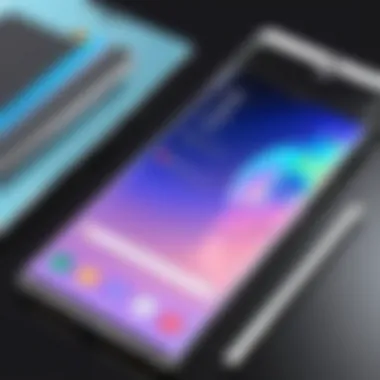

- Forgetting to Power Down: Always ensure your device is completely powered down before starting any disassembly. This minimizes the risk of short circuits and protects the delicate internals.
- Neglecting to Ground Yourself: Static electricity is a silent enemy. Not using an anti-static wrist strap can lead to static discharge, potentially damaging sensitive components. Ground yourself before touching any internal parts.
- Improper Tool Usage: Using the wrong tools, such as using metal tools in a place where plastic ones should be employed, can scratch or break internal components. It’s essential to utilize the right tool for each specific task.
- Rushing the Process: Patience is key. Hurrying through the steps can lead to missing critical connections or damaging components, making the situation worse.
- Skimping on Adhesion: When securing the new screen, using inadequate adhesive can leave it loose, risking further damage. Use appropriate double-sided tape or adhesive designed for screen repairs.
"Mistakes in replacement don’t just cost time; they could cost you your device. Pay attention to details."
By being vigilant about these common missteps, you can save yourself a lot of headaches post-repair.
Warranty Considerations
One aspect that often gets overlooked during the repair process is the warranty of the Samsung Note 10. It’s crucial to understand how your actions can void existing coverage. Here’s what you need to consider:
- Manufacturer Warranty: Samsung devices typically come with a warranty that covers manufacturing defects. Any unauthorized repair, including DIY screen replacements, can void this warranty. Before diving into a replacement, check if your device is still under warranty and whether it might be more beneficial to seek official service.
- Third-Party Warranty: If you have a third-party protection plan, review the specifics. Some options cover accidental damage and repairs, while others may not. Engaging in self-repair could be a breach of terms in many cases.
- Documentation: If you plan to replace the screen, keep records of the process. Take before and after photos, and note any replaced parts. This documentation can be helpful for claims or future repairs.
- Repair Costs vs. Warranty Costs: Sometimes, the expense of professional repair covered under warranty could end up saving more than a DIY fix, especially if risks are involved in the latter that could lead to more severe damage down the line.
Thoroughly considering these warranty implications ensures that you’ll make an educated choice about whether to DIY your screen replacement or rely on professional services.
By being mindful of pitfalls and understanding warranty coverage, you can navigate the Samsung Note 10 repair process more effectively, ensuring both functionality and protection.
Cost Implications of Replacement
When it comes to replacing the screen and digitizer of your Samsung Note 10, understanding the cost implications can feel like deciphering a puzzle. Not only does it impact your wallet, but it shapes the entire repair decision-making process. Thus, understanding the various cost factors involved is crucial for a clear-eyed assessment of your options. This section will walk you through some specific elements, benefits, and considerations that make up the overall cost picture.
Estimating Repair Costs
Repair costs can vary significantly depending on a multitude of factors, including parts, labor, and location. It's essential to break down these components to get a clearer view of what you're getting into.
Parts Pricing
One of the largest slices of the pie when it comes to repair costs is parts pricing. The market offers a range of options, from OEM (original equipment manufacturer) parts that typically come at a premium to cheaper third-party alternatives. Knowing what you'd like to invest can guide your choice.
Here’s why parts pricing is a pivotal aspect of this replacement:
- Quality Control: OEM parts tend to ensure a better alignment with your device. They resemble your original screen, both in look and performance, minimizing potential issues down the line.
- Cost Variability: Ballpark figures for replacement parts usually land between $100 to $300. The actual cost can hinge on the supplier's pricing and whether there’s any ongoing promotion—always worth checking.
- Investment Longevity: Choosing a higher-quality part might feel like a splurge now, but it can save you from future expenses related to replacements or repairs, making it a financially prudent decision.
In essence, weighing your options with a focus on durability versus price can lead to better long-term satisfaction.
Labor Costs for Professional Repair
The other side of the coin is labor costs for professional repair. While it may be tempting to roll up your sleeves and tackle the repair yourself, sometimes it's worth leaving it to the pros.
Let's dive into why labor costs are significant:
- Skill Level: A trained technician has the expertise to avoid common pitfalls that might not be apparent to a novice. They typically charge between $50 and $150 for the labor alone, which can save you the headache of a botched job.
- Time Savings: Repairing a screen isn't a quick task for an amateur, and the cost of your time can add up. A professional can often get the job done in about an hour, letting you return to your daily routine sooner.
- Warranty Benefits: Many repair services provide a warranty on their work. This acts as a safety net, offering peace of mind in case the replacement doesn’t hold up to expectations.
Although it may seem like a steep price to pay initially, the fresh set of eyes and hands on your device often pays off in quality and reliability.
Comparison with Buying a New Device
As you weigh repair costs, it’s vital to juxtapose this with the cost of a new device. Bringing a new phone into your life might require a hefty upfront investment, typically pricing from $800 to over $1000 for new models, while repair costs often sit substantially lower.
When considering whether to repair or replace:
- Age of Your Device: If your Samsung Note 10 is still performing well in other aspects, a screen replacement can extend its useful life without the eye-watering expense of buying a new device.
- Dependability: If the phone has shown signs of degradation beyond the screen—like battery issues—its value diminishes further.
- Personal Attachment: Sometimes, it's just about wanting to hold onto what you’ve grown accustomed to. Replacing the screen can breathe new life into an old friend, making it feel like new again.
Remember, a well-informed decision today can spare you from buyer's remorse down the line.
The End and Final Thoughts
In wrapping up this guide on replacing the Samsung Note 10 screen and digitizer, it's vital to underline just how crucial these repairs can be for maintaining the device's functionality. There's a fine line between a simple fix and a potential headache, and knowing when and how to proceed can make all the difference. This article doesn't just go through the nuts and bolts of the repair process; it emphasizes making informed decisions and preparing adequately before diving into any hands-on work.
The elements discussed above serve not just as a checklist but as a holistic approach to ensuring that your device is not only repaired but also primed for continued usage going forward. One of the key aspects is understanding the cost implications. It’s all too easy to underestimate what you might be spending when you find yourself needing to source parts – both online and in stores.
Additionally, evaluating whether you should attempt the repair yourself or tap into professional services can save you time, frustration, and possibly even more financial burdens down the road. A thorough assessment of personal skills and available tools plays a fundamental role here.
"Knowledge is like a seed; plant it well and watch it flourish."
Having discussed the replacement process, it’s equally important to think ahead. Making informed decisions today can mean the difference between a smooth, efficient repair and a myriad of complications later. With that in mind, let’s look at how to ensure your device remains in peak condition moving into the future.
Making an Informed Decision
When it comes to deciding whether to undertake the screen and digitizer replacement yourself, there are several factors to weigh. First, is your comfort level with disassembling electronic devices? If you've tackled repairs before, that might lend you some confidence. However, if your experience is more on the theoretical side, you may want to consider enlisting a professional.
There’s always the risk of causing more damage than you started with. After all, the last thing you want is to crack the new screen you've just invested in. Moreover, consider your time and how important the device is for daily use. If your Samsung Note 10 is essential for work or communication, perhaps it’s better to leave the heavy lifting to someone who does this all day, every day.
Moreover, have a look at warranty considerations as well. Attempting a DIY repair can void your warranty with your manufacturer, so always check the fine print before going forward. Making a well-informed decision not only saves you from potential pitfalls but enhances the longevity of your device.
Future Maintenance Tips
To keep your Samsung Note 10 in top shape post-repair, a little TLC goes a long way. Here are some practical tips:
- Use a Quality Screen Protector: Protect against scratches and lower the risk of further damage from drops.
- Regular Cleaning: Use a microfiber cloth and gentle cleaner on your screen, keeping it free from oils and grime.
- Avoid High Temperatures: Heat can adversely affect your device; try not to leave it in a hot car or in direct sunlight for extended periods.
In addition, remaining observant for any signs of trouble early on can prevent larger issues. If you notice any flickering or responsiveness issues shortly after the repair, seek help sooner rather than later. Addressing these concerns early can lead to simpler fixes and may keep your device running smoothly for longer.
By staying proactive with maintenance and understanding when professional assistance may be required, you can extend the life of your Samsung Note 10 and enhance your overall experience with it.



